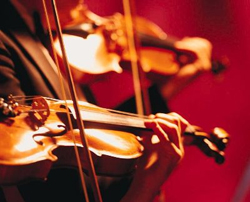Strings are arguably the most expressive instrument next to the human voice.
Knowing how powerful string instruments can be, it’s often intimidating recording them.
It’s impossible to give an exact formula for the best string sound – but I have a few key tips that will really help you get that beautiful singing string sound.
A Sense of Space
Figure out where the strings will be in the mix, and the tracking will fall into place. Are the strings up front and bold, or are they providing a back drop?
If you are going for a “soul style” string section, you can place the string overheads surprisingly close to the players, because you may want the heavy harmonics and a sense of “in-your-face.”
For classical inspired rock, your power is really going to come from the guitars and drums. You’d be surprised how far you can place the string overheads because the strings are meant to create width and depth – and not fight with the power instruments.
With an orchestra, you will probably have both a close overhead set and a far room capture – as you want both power and depth from your ensemble. Figuring out the strings role, and spatial relevance is half the battle.
Choose Your Weapons
Many people will swear by ribbon mics for string work, others will go for condensers, and within that there’s the choice of polar patterns. A thorough understanding of what different mics can help do will answer the question.
Ribbons are great for three reasons:
—There’s top end roll off. This will help accentuate a sense of distance, and also ease back any glassy harmonics that might be coming off the violins. Even if it’s too much roll off, you can eq up the high end and accentuate the “air” without too much glass (watch out for ribbon hiss though).
—Second, ribbons are true figure 8 captures. If you want width you can have space ribbons and get more separation, or Blumlein your ribbons for a relatively wide stereo with a concentric mono.
—Last, the transient response on most ribbons is a little lethargic, which is great for naturally rounding out any hard staccato string moments – no compression needed in the mix phase! Some ribbons just have a sweet ass tone to them on top of all that (technically speaking).
Condensers have advantages as well:
—You will get a fuller scope – a clear sound – of the ensemble.
—Especially with the harmonics, you’ll also get a nicer all around sound of the room.
Essentially, choosing the mikes is about that which fits the role best. Ribbons and condensers can both sound fantastic on any string set with the right placement. It’s more about what kind of image you want.



















